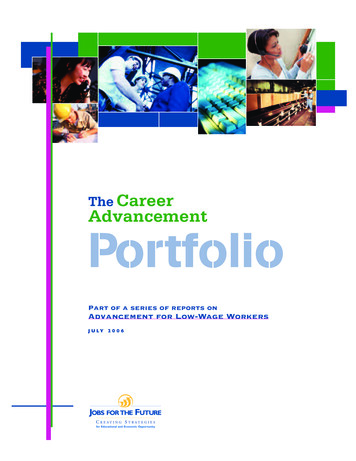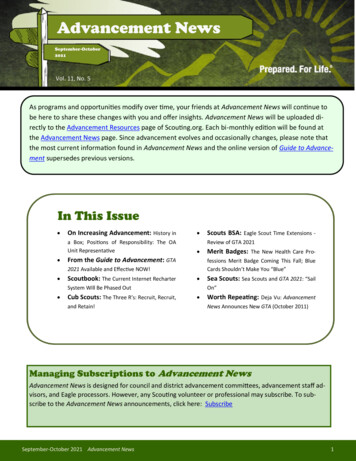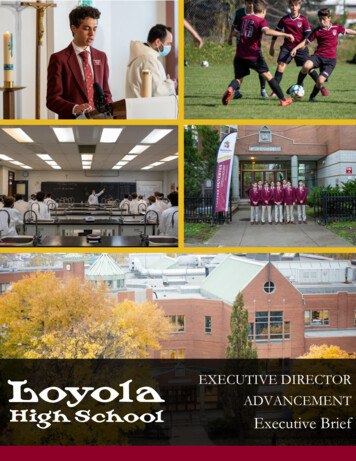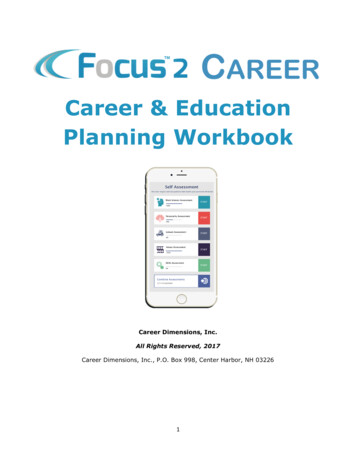
Transcription
The CareerAdvancementPortfolioPart of a series of reports onAdvancement for Low-Wage WorkersJ U LY 2 0 0 6
JOBS FOR THE FUTURE seeks to accelerate the educational and economic advancement ofyouth and adults struggling in today’s economy. JFF partners with leaders in education,business, government, and communities around the nation to: strengthen opportunitiesfor youth to succeed in postsecondary learning and high-skill careers; increase opportunities for low-income individuals to move into family-supporting careers; and meet thegrowing economic demand for knowledgeable and skilled workers.
The Career AdvancementPortfolioTable of ContentsFocusing on Careers, Not First Jobs . . . . . . . . . . . . . . . . . . . . . . . . . . . . . . . . . . . . . . . . . . . . . . . . . . . . . . . . . . . . . . . . . . . . . . . . . . . . . . . . . . . . . . . . . 1Focusing on Models . . . . . . . . . . . . . . . . . . . . . . . . . . . . . . . . . . . . . . . . . . . . . . . . . . . . . . . . . . . . . . . . . . . . . . . . . . . . . . . . . . . . . . . . . . . . . . . . . . . . . . . . . . 2A High Standard: Criteria for Portfolio Membership.2The Founding Portfolio Members . . . . . . . . . . . . . . . . . . . . . . . . . . . . . . . . . . . . . . . . . . . . . . . . . . . . . . . . . . . . . . . . . . . . . . . . . . . . . . . . . . . . . . . . . . . 3Community College of Denver . . . . . . . . . . . . . . . . . . . . . . . . . . . . . . . . . . . . . . . . . . . . . . . . . . . . . . . . . . . . . . . . . . . . . . . . . . . . . . . . . . . . . . . . . . . . 4District 1199C, National Union of Hospital and Health Care Employees,American Federation of State, County and Municipal Employees . . . . . . . . . . . . . . . . . . . . . . . . . . . . . . . . . . . . . . . . . . . . . . . . . . . . . . . . . 4Wisconsin Regional Training Partnership . . . . . . . . . . . . . . . . . . . . . . . . . . . . . . . . . . . . . . . . . . . . . . . . . . . . . . . . . . . . . . . . . . . . . . . . . . . . . . . . . . 4Workforce Alliance and Hospital Corporation of America . . . . . . . . . . . . . . . . . . . . . . . . . . . . . . . . . . . . . . . . . . . . . . . . . . . . . . . . . . . . . . . . . 5WorkSource Partners . . . . . . . . . . . . . . . . . . . . . . . . . . . . . . . . . . . . . . . . . . . . . . . . . . . . . . . . . . . . . . . . . . . . . . . . . . . . . . . . . . . . . . . . . . . . . . . . . . . . . . . 6Year Up . . . . . . . . . . . . . . . . . . . . . . . . . . . . . . . . . . . . . . . . . . . . . . . . . . . . . . . . . . . . . . . . . . . . . . . . . . . . . . . . . . . . . . . . . . . . . . . . . . . . . . . . . . . . . . . . . . . . . 6The Future of the Career Advancement Portfolio . . . . . . . . . . . . . . . . . . . . . . . . . . . . . . . . . . . . . . . . . . . . . . . . . . . . . . . . . . . . . . . . . . . . . . . . . . . 7
Jobs for the FutureThe Career AdvancementPortfolioJobs for the Future’s Career Advancement Portfolio is a collaborative effort to enhance, expand, and dis-seminate proven solutions for advancing low-income people to good jobs. Each of the organizationsin the Portfolio operates advancement models that clearly demonstrate and document success,with well-delineated features that can be replicated or scaled up. JFF created the Portfolio as central toour commitment to developing, implementing, and advocating for models, strategies, and policiesthat enable adults to advance toward economic self-sufficiency for themselves and their families.However, as workforce development practitioners and policymakers know all too well, it is difficult,time-consuming, and expensive to implement advancement programs, particularly for individuals withthe lowest skill levels. In response, the Portfolio makes a compelling case for increasing both public andprivate investments in proven advancement solutions that help low-wage workers achieve family-sus-taining incomes.Focusing on Careers, Not First JobsWorkforce development programs targeting low-skilledworkers often focus on “first job” placements. Whilegaining access to first jobs is beyond doubt critical, theemployment and training field pays far too little attention to “next step” programs that lead from entry-leveljobs to higher skills, better pay and, in time, opportunities for rewarding, lifelong employment. Practices andstrategies that focus on advancement are essential, withtheir insistence that the first job is not a dead end butone step on a career track.For low-skilled, low-wage workers, clear benefits follow from efforts that focus resources, activities, and public policy on generating opportunities to advance skills,incomes, and careers. Too many Americans who workhard cannot escape poverty through their wages alone.More than nine million working Americans—25 percentof whom work full time, year round—earn less than theofficial poverty level, and more than 40 millionAmericans earn below 200 percent of the poverty level, awidely accepted proxy for a minimum family-sustainableincome. This might not be a problem if it were easy toadvance over time, either in the same firm or outside it,through seniority or on-the-job training. Unfortunately,large numbers of low-skilled workers are trapped in jobsthat provide few if any opportunities to improve wages,skills, and career opportunities.For employers, the benefits of an advancementframework for workforce development are just as significant. In fact, WorkSource Partners, a CareerAdvancement Portfolio member, has estimated that one ofits employer customers, a long-term care provider, savesover 500,000 each year in reduced employment agency1
2The Career Advancement PortfolioThe Career Advancement Portfolio makes acompelling case for increasing both publicand private investments in provenadvancement solutions that help low-wageworkers achieve family-sustaining incomes.the efforts depend to some extent on public funds.Public funding is particularly important in enlargingthe scope of models that have demonstrated a substantial return on investment. The Portfolio makes a compelling case for philanthropic and corporate investments in advancementmodels. This documented, diverse set of promisingmodels provides guidance for philanthropic and corporate investors seeking to advance low-wage workers.A High Standard: Criteria forPortfolio Membershipfees and reduced turnover at its five nursing homes. Inindustries as diverse as manufacturing, hospitality, financial services, and construction, employers and independent organizations have documented persuasive returns onemployer investments in advancement efforts.Documented cost savings result from higher productivity, more efficient staff recruitment, and improvedemployee retention.Focusing on ModelsThe Career Advancement Portfolio brings together themost innovative workforce development practices forimproving the lives of low-skill, low-income adults. Itanswers the need for effective, proven, replicable, andscalable models of approaches that advance low-incomeindividuals to jobs with high enough wages to move families out of poverty.Collectively, the models in the Career AdvancementPortfolio point to ways to promote and benefit from practices and policies that improve the economic status oflow-income, low-skilled adults: The Portfolio provides “best practice” designs forcommunities, employers, and others interested indeveloping effective advancement models. By capturing models that advance low-wage workers into betterjobs, the Portfolio offers an important resource for practitioners, policymakers, and potential investors. The Portfolio makes a compelling case for increasedpublic investments. Employers have invested, to someextent, in most of the models in the Portfolio, but allEvery program in the Career Advancement Portfolio meetsrigorous criteria, beginning with achieving key outcomesfor low-income workers. JFF intentionally set the standards for inclusion high: for advancement programs, theycreate a goal worth aspiring to; for employers, foundations, and other public and private investors in workforcedevelopment, they are benchmarks that can be applied toother efforts.Every Career Advancement Portfolio member, throughone or more of its models, meets six criteria: Advances low-skilled workers into well-paying,career-track jobs: The model advances low-income,low-skilled individuals into jobs that pay at least 80percent of the local, metropolitan-area, or state medianwage. The jobs also come with health benefits and offerstrong opportunities for continued wage and careergrowth. Responds to strong employer or labor marketdemand: The model develops skills for which there ishigh demand. Typically, the models assign employersan important program design role in identifying skillrequirements. Demonstrates results: Data on outcomes or other evidence shows that the model is successful in advancinglow-wage workers. Shows strong potential for scale and replication: Themodel is specific and clear. It includes standardized features and operational design, viable financing, highpolitical or employer demand for the solution it represents, etc.
Jobs for the Future Offers a “best in class” approach to low-wageworker advancement: Clear strengths or advantagesset the model apart from current practice. It providesan innovative service delivery or design method thataddresses traditional barriers to low-wage workeradvancement. Demonstrates interest by leadership in promotingand spreading the model: The “owner” of the modelworks with Jobs for the Future to document and disseminate key features and outcomes. The owner isinterested in expanding its own efforts or willing tohelp others adopt the model for replication.The Founding Portfolio MembersIn 2006, Jobs for the Future selected six founding members of the Career Advancement Portfolio. These organizations are: Community College of Denver; District 1199C, National Union of Hospital andHealth Care Employees, American Federation of State,County and Municipal Employees; Wisconsin Regional Training Partnership; Workforce Alliance and Hospital Corporation ofAmerica; WorkSource Partners; and Year Up.Each organization operates one or more models thatoffer proven and scalable career advancement solutionsfor low-skilled workers. JFF has worked with each ofthese organizations in various capacities, providing strategic advice on growth, designing approaches to measuringindividual and organizational outcomes, or assisting withmarketing activities to potential funders and communitypartners.Both WorkSource Partners and the WisconsinRegional Training Partnership were winners of JFF’s2003 Career Advancement Strategy Competition, whichwas supported by U.S. Department of Labor as part ofthe WINs project. This competition identified advancement models demonstrating results for employers andincumbent workers.In 2004, Community College of Denver received theMetLife Community College Excellence Award, which JFFadministers, and it is a Leadership College in BreakingThrough: Building Effective Pathways to CollegeCredentials, a partnership of JFF and the NationalCouncil for Workforce Education to promote andenhance the efforts of community colleges to help lowliteracy adults prepare for and succeed in occupationaland technical degree programs.JFF has worked closely with Year Up, providingstrategic advice on business planning, program design,fundraising, and the development of a performance management system.A small grant from JFF helped 1199C gain accreditation for its LPN program. Following that, the organization used JFF’s documentation of the LPN model toleverage additional funding.The Workforce Alliance’s model for training peopleto become Licensed Practical Nurses was featured inJFF’s report, From Entry Level to Licensed Practical Nurse:Four Case Studies of Career Ladders in Health Care. Themodel has been widely publicized in an effort to raise theprofile of advancement models in health care.3
4The Career Advancement PortfolioDistrict 1199C, National Union of Hospitaland Health Care Employees, AmericanFederation of State, County and MunicipalEmployeesCommunity College of DenverResponding to employer needs for skilled nurses, theCommunity College of Denver operates a program thatenables Certified Nursing Assistants and other entrylevel workers to advance to become Licensed PracticalNurses. The training accommodates employed adults byoffering coursework on a part-time basis and duringevenings and weekends. In addition, the classes takeplace at employers’ work sites. An accelerated remedialeducation component increases the academic preparedness of participants.This worksite LPN training program is designed tomeet employer needs for skilled nurses while providing acareer advancement ladder for dedicated, frontline caregivers. As such, it relies upon employer support for itssuccess, and they are key partners. Employers adjust thework schedules of participating employees to accommodate program demands. In addition, most employershelp participants pay for tuition and fees; some providepaid release time.The program began in 2002 with one cohort oftwenty students. Since then, sixteen cohorts have begunthe program, and seven have completed it. The programhas a remarkable retention and completion rate, despitethe low incoming reading and math levels of participants. Sixty-seven percent of those who began the program have either earned their LPN diploma or are stillenrolled.The District 1199C Training and Upgrading Fund offersan educational track leading to Practical Nursing jobs fornursing assistants and other entry-level health care workers. The program lasts 18 months, with classes held inthe evenings and on weekends to accommodate workschedules. It is the only union-sponsored nursing program in the country and one of the few that meet theneeds of working adults through a part-time schedule.The fund is jointly administered by District 1199C andrepresentatives of approximately 55 contributing healthcare employers.The fund opened the Practical Nurse training program in 1999, two years after the School District ofPhiladelphia closed its PN program. Since opening itsdoors with 31 students, the new program has grownsteadily and now enrolls 120 students per year.Between 1999 and 2005, 396 individuals entered thePractical Nursing program upon completing a preparatory “bridge” experience. Of those, 185 had completedthe program by 2005, 85 were still enrolled, and 126 didnot complete it; 81 percent of graduates passed the LPNlicensure examination on the first attempt.Everyone in the PN class that graduated in June2005 passed the LPN licensure examination on the firstattempt.Wisconsin Regional Training PartnershipIn 2005, the Wisconsin Regional Training Partnership, aworkforce intermediary jointly led by labor and management, placed its 2,500th community resident into a family-sustaining job in the Milwaukee area. That same year,WRTP partnered with the BIG STEP apprenticeshippreparation program to launch the Center of Excellenceto address an unprecedented boom in construction and askills shortage in advanced manufacturing. The centerprovides, for the first time, a single point of contact forthe workforce needs of skilled trades and industries. Itplaced 348 community residents at an average startingwage of 14.60 per hour plus benefits during its first year.The center has obtained support from the governor,the mayor, and an unprecedented array of public, private,and philanthropic sector partners. These include the
Jobs for the FutureWisconsin Department of Workforce Development, theDepartment of Transportation, and the Department ofCorrections, the City of Milwaukee, national and localfoundations, business and labor organizations, educational institutions, and community organizations. Foremployers and job seekers, the center has streamlinedservices, including the identification of trainingresources, the job referral process, employment projections for construction projects, training requirements,and the need to develop marketing materials related tocareer opportunities in skilled trades.The pinnacle of center programs is BIG STEP, whichincreases access to the building and construction tradesfor women and minorities. BIG STEP focuses on developing the academic skills needed to pass the apprenticeship entrance exam required to work in the field.Between 2001 and 2005, BIG STEP placed 200 of itslow-income graduates in skilled trade apprenticeships,more than all other programs in the area combined. Twothirds were people of color and 14 percent were female.Earnings at placement were about 12 to 15 per hour,depending on the trade.Workforce Alliance and HospitalCorporation of AmericaThe Workforce Alliance (the Palm Beach, Florida,Workforce Investment Board) partners with threeHospital Corporation of America facilities to provideworking adults with access to Licensed Practical Nursetraining. The part-time, two-year program meets twice aweek for nine hours. Participating employers offer flexible work schedules that enable employees to continueearning an income while in the program.The training is delivered by the Academy forPractical Nursing and Health Occupations, an accredited, not-for-profit postsecondary institute that specializes in serving less-formally educated, low-income adults.ACS State and Local Solutions provides case management services to the students, and the Palm BeachCounty Literacy Coalition provides remedial reading,writing, ESL, and math instruction that helps candidatesprepare for entrance exams.The program enrolled its first class of 36 LPNtrainees in January 2002; 23 of them successfully completed the LPN training. Since then, the program haslaunched two additional classes, one in December 2003and another in December 2004, enrolling a total of 73students. Of these, 56 were still enrolled in the programin 2005 and on target to graduate by December 2006.Across the three classes, over 150 employees haveparticipated in remedial literacy and math instruction.Of those who attended at least 25 hours of instruction,30 percent subsequently passed the TABE and qualifiedfor admission into the LPN program. An additional 78students raised their reading and math levels.5
6The Career Advancement PortfolioFor organizations engaged in workforceefforts serving low-income, low-skilledadults, the Career Advancement Portfoliomodels provide insight into effectivepractices with demonstrable results. Theycan also help guide public investment ineffective workforce strategies—resourcesthat are critical for such programs.WorkSource PartnersWorkSource Partners provides and coordinates workforcedevelopment training, career counseling, and hiring services for companies such as CVS/pharmacy, GenesisHealthCare, Gillette, and Partners HealthCare System. Ithelps its clients invest in their entry-level workers andaddress the significant “skill gaps” in today’s workforcethrough the delivery of career initiatives for entry-levelemployees.WorkSource Partners addresses workforce shortagesin long-term care through Regional AdvancementCenters. This innovative training model brings careeradvancement services, including career counseling andcommunity college courses, to the work site. By partner-ing with local community colleges, WorkSource Partnerscan provide a full sequence of preparatory educationalcourses, as well as a customized evening LPN program onsite. Regional Advancement Centers are helping lowskilled Certified Nursing Assistants and other entry-levelworkers in nursing homes to advance to becomeLicensed Practical Nurses.By bringing pre-college and college education to theworkplace in conjunction with career counseling andcase management, the Regional Advancement Centeroffers employers a “grow your own” career advancementmodel. Through reduced staff turnover and lowered jobvacancy rates, this strategy has both yielded significantfinancial benefits to employers and improved patientcare. One long-term care firm ended its use of agencynurses to fill LPN vacancies at five facilities—savingmore than 500,000 per year since January 2001. Thefirm has reduced turnover among nursing assistants significantly. Facilities at another firm have enjoyed similarbenefits; CNA turnover rates dropped by 30 to 40 percent in two years.Year UpYear Up prepares low-income, urban young adults for,and places them in, entry-level jobs in information technology and investment operations, while also preparingparticipants for college. The program targets recent highschool graduates and GED recipients between the ages of18 and 24 who are either unemployed or trapped in minimum-wage, dead-end jobs. It provides them with anintensive year of technical, professional, and businesscommunications training. It also provides an apprenticeship experience, college credit, and a high degree of personal and academic support.Year Up’s corporate customers include large financialservices companies, technology firms, hospitals, and stategovernment. They pay the program a fee of 685 to 785 a week per intern. This provides Year Up with afunding stream that covers more than 45 percent of itsoperating expenses.Year Up has placed 87 percent of its graduates in jobs,at an average pay of 14.92 per hour; roughly 44 percentof graduates have gone on to college. The model is inplace in Boston, Providence, and Washington, DC; afourth site is opening in New York City in September2006. Plans are to expand to additional locations andindustries.
Jobs for the FutureThe Future of the CareerAdvancement PortfolioJobs for the Future is committed to making the CareerAdvancement Portfolio a valuable resource for those concerned about improving the lives of low-income, lowskilled adults. The models included in the Portfolio meetstringent criteria and present “best in class” designs forpractitioners, funders, and employers. For organizationsengaged in workforce efforts serving this population, thePortfolio models provide insight into effective practiceswith demonstrable results. It can also help guide publicinvestment in effective workforce strategies—resourcesthat are critical for such programs.JFF will build the Career Advancement Portfolio in thecoming years, adding two to four new sites per year, cultivating models in identified industries, and expanding tonew ones, such as manufacturing and automotive technician. JFF also anticipates that several of its projects andpartnerships will contribute to the Portfolio in the coming years. Breaking Through: Helping Low-Skill AdultsSucceed in College and Careers may identify communitycollege-based advancement models in manufacturing,health care, and the construction trades. SkillWorks:Partners for a Productive Workforce is fostering innovativepartnerships between workforce development practitioners and employers in the automotive and hospitalityindustries. Jobs to Careers: Promoting Work-BasedLearning for Quality Care is designed to lead to newmodels for advancing frontline workers in health carewhile also improving the quality of care.Moving forward, JFF will help each Portfolio memberpromote its visibility among potential investors and inthe workforce field. Potential activities include assistancewith public relations, financial support, advice on strategic planning, the documentation of practices, and thefacilitation of connections with potential partners andinvestors. JFF’s goal is to continue supporting, promoting, and identifying exemplary advancement activities—and to disseminate their achievements and examplesbroadly in order to improve the prospects of low-incomeworkers across the nation. The Portfolio models representdemonstrated innovations that stand to significantlyimprove the design of workforce development strategiesfor low-wage and low-skilled workers.JFF’s goal is to continue supporting,promoting, and identifying exemplaryadvancement activities—and todisseminate their achievements andexamples broadly in order to improve theprospects of low-income workers acrossthe nation.7
8The Career Advancement PortfolioJobs for the Future’s Career Advancement PortfolioThe Career Advancement Portfolio grows directly out ofseveral JFF activities to identify, support, and promoteon-the-ground workforce development programs withclearly delineated operational features that help lowskilled adults move up skill and wage ladders.JFF ProjectsBreaking Through: Helping Low-Skill Adults Succeed inCollege and Careers: This multi-year demonstration project promotes and enhances the efforts of community colleges to help low-literacy adults prepare for and succeedin occupational and technical degree programs. The project is a partnership of JFF and the National Council forWorkforce Education.Career Advancement Strategy Competition: With supportfrom the U.S. Department of Labor, JFF identified over400 employer-led advancement models around the country. JFF provided direct technical and financial supportto four programs as a result of the competition.Community College Advancement Project: The Annie E.Casey Foundation provided JFF with support to identifyadvancement models that are based in community colleges and focus on moving low-skilled working adultsinto and through occupational certificate and degree programs tied to career advancement. Following on thatresearch, JFF provides technical and financial support totwo community colleges to scale up their advancementmodels.Investing in Workforce Intermediaries: The Annie E. Casey,Ford, and Rockefeller foundations, working with JFF,have launched this effort to seed a national support infrastructure for workforce intermediaries. The six projectsites are changing the way communities meet the skillsneeds of workers and businesses.Jobs to Careers: Promoting Work-Based Learning forQuality Care supports partnerships to advance andreward the skill and career development of incumbentworkers providing care and services on the front lines ofour health and health care systems. The project is anational initiative of the Robert Wood JohnsonFoundation, in collaboration with the HitachiFoundation. Jobs for the Future, as the National ProgramOffice, manages the initiative and provides technicalassistance to the grantees.SkillWorks: Partners for a Productive Workforce is thelargest effort in Boston’s history to substantially improveworkforce development services for both low-skill/lowincome residents and for business. The initiative bringsmajor new investments from a coalition of Boston andnational funders, including state and local public-sectorresources, to lay the foundation for sustained improvements in the city’s workforce development services.Skill Up Rhode Island is an economic development initiative based on the SkillWorks model. This effort, a freshapproach to job training for low-income, low-skilledRhode Islanders, engages both job seekers and employerswho hire them.Selected JFF Publications on Advancementfor Low-Wage WorkersThe Next Challenge: Advancing Low-Skilled, Low-WageWorkers (2004): This brief argues for placing not justemployment but also advancement at the center ofemployment and training policy. It defines careeradvancement as a goal, explores key challenges andopportunities, and highlights strategies to help significantly more low-skilled workers move up to better jobsand family-supporting earnings.Building Skills, Increasing Economic Vitality: A Handbookof Innovative State Policies (2005): This handbook forpolicymakers and practitioners highlights some of themost promising and exciting developments in state workforce and skill development policy.Career Ladders: A Guidebook for Workforce Intermediaries(2003): This CD-ROM-based guide provides information and extensive resources on planning, developing,operating, and expanding the role of intermediaries, anapproach central to many advancement strategies.The Center of Excellence: Meeting the Workforce Needs ofthe Milwaukee Construction Industry (2006): The center,launched in 2005 by the Wisconsin Workforce TrainingPartnership and BIG STEP, provides a single point ofcontact for meeting the workforce needs of theMilwaukee area’s skilled trades and industries.
Jobs for the FutureEarning While Learning: Maintaining Income WhileUpgrading Skills (2004): A number of programs andpractices encourage skill development by providingincome and supports to those pursuing further educationand training.Opportunity in Tough Times: Promoting Advancement forLow-Wage Workers (2003): This report describes ways tomaintain efforts to advance low-wage workers in the faceof exceedingly difficult conditions. It draws on interviewswith innovative state officials and practitioners.Education and Skills for the 21st Century: An Agenda forAction (2005): In September 2005, The Fate of theAmerican Dream brought together top corporate, education, and workforce policymakers to address the failureto prepare the nation for the demands of the knowledgebased, global economy of the 21st century. The ActionAgenda, which JFF released at the forum, looks at how“Our Success Is Our Graduates”: Case Study of Year Up: ACareer Advancement Model for Low-Income Young Adults(2005): Year Up, an innovative technology training program, prepares and places low-income, urban youngadults in entry-level IT jobs while also preparing themfor college.the nation can take advantage of today’s best innovationsand new models to rebuild and extend the educationpipeline for tomorrow’s needs.Reinventing Workforce Development: Lessons from Boston’sCommunity Approach (2004): The experience ofSkillWorks, a public/private initiative in Boston, offersstart-up lessons for workforce development reform effortsEmployer-Led Organizations and Career Ladders (2003):throughout the nation—and for any community thatThis issue brief reviews key elements and processesinvolved in creating career l
District 1199C, National Union of Hospital and Health Care Employees, American Federation of State, . This worksite LPN training program is designed to meet employer needs for skilled nurses while providing a career advancement ladder for dedicated, fr ontline care-givers. As such, it relies upon employer support for its










